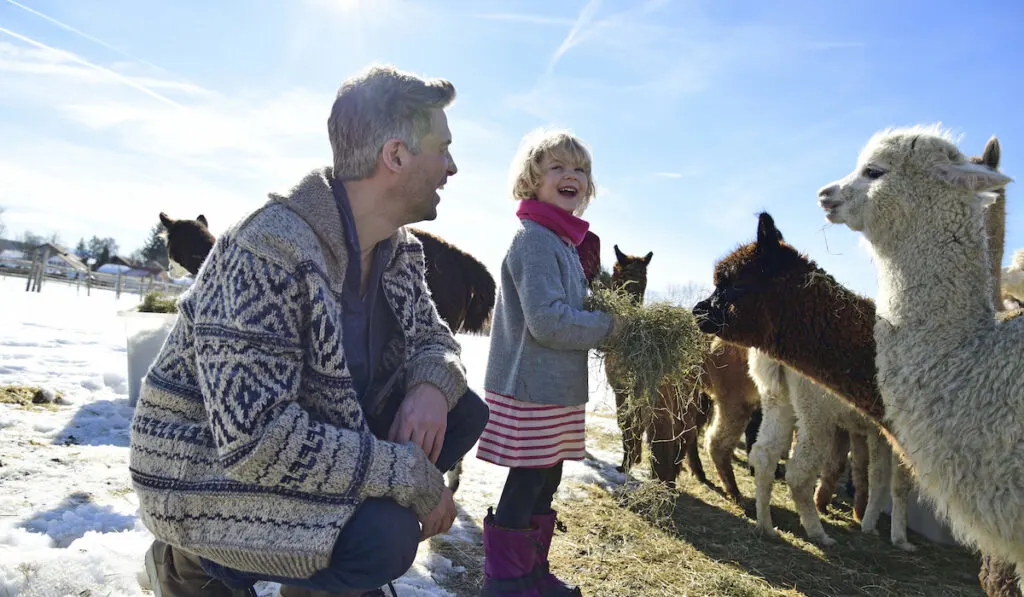We know why you’re here. You’re thinking about getting a llama but you’ve seen all of those YouTube videos of them spitting at people who get too close. They look cool and their fur looks so soft, but you’re not sure whether you want to invest in an animal you can’t build a relationship with.
Are llamas friendly? Well, first you should know that llamas tend to be very territorial animals. In fact, one of the reasons a lot of farmers and property owners keep llamas is because they tend to scare off foxes and coyotes trying to get to their chickens and sheep.

Llamas are big enough and capable of being aggressive enough to make predators think twice before setting foot in your yard or on the farm. Once llamas know who you are and that you belong on the property, though, they are fantastic to keep as family pets.
We’ve put together some information on llama care and their temperament to best prepare you for bringing a llama onto your property. Knowing what makes them tick and how you can form a bond with your llama will help you and your llama get acclimated more quickly.
Table of Contents
The Typical Llama Temperament
Every animal is different. Let’s just get that out of the way. It’s hard to use blanket terms for dogs, as you can imagine, so it can also be difficult to describe llamas in broad terms. Every llama’s personality will differ to some degree.
They are curious animals that will saunter up to the fence when you come around. They’re looking for treats or just to give you a look over.
The problem people run into is when they over-handle or get too close to the llama when they’re young. If you bottle-feed a baby llama and raise it to an adult, then it’s going to treat you and other humans more like they would other llamas.
That means occasional spitting when you get too close or neck wrestling as a form of play (you might not think it’s too fun).
You can avoid this by keeping interactions to a minimum while the llama is young.

A Llama as a Pet
Knowing that, let’s move on to describing what you can expect from keeping a llama as a pet. Generally speaking, llamas are friendly, low-maintenance animals with a cheerful disposition.
They have mild manners around people they know, and will only show small signs of displeasure if they are stressed or want someone to go away (the spitting).
Llamas do very well in different climates. They can withstand the cold and can get through hot summers as long as there is plenty of fresh water and some shade to hide under. They love to graze, so you’ll need to make sure you have the space to support a llama before you buy one.
Depending on where you live, your property will also need to be zoned for livestock if you don’t want to run into any issues with the government.
Llamas Are Very Social Animals
One thing you may want to consider is whether getting only one llama is a good idea. It’s probably a lot to ask to get two or more llamas at the start, but these animals will be happier when there are more of them around.
On any property with multiple llamas, you can usually see them grazing, walking, or standing in crowds. They love to be together.
Again, the main consideration for getting one or five llamas is whether you have the space and the grass to keep them comfortable and happy.
If you’re dying to own a llama, but you don’t have a big yard or live somewhere it’s impossible, you can always find a farm to board your llama for a small monthly fee ($1-200).
Llamas Have a Calming Presence
There’s something about the way a llama looks and moves that can reduce stress and make everyone around relax. They are always a big draw at petting zoos and small farms across the country.
Maybe it’s something about their soft fur or their long necks, but people love being around them, and they are friendly to boot!
Some people take their llamas through comfort animal training to use for people who seek out animal therapy or comfort animals.

Finding a Vet Near You that Specializes in Llamas
Llamas are large and unique animals. People don’t usually take horses, for instance, to a vet in a strip mall.
Big animals typically call for vets who specialize in their care. Llamas are susceptible to parasites and usually need regular checkups to keep them in good shape.
They also have long limbs and are walking on fields with uneven ground. Llamas frequently break legs or sprain ankles, so you’ll need a vet around who can help.
Bonding with Your Llama
Bonding will usually depend on how old your llama is and their background. Remember, these animals can be territorial, so they may not take to you coming up and petting them kindly.
Give it some time. Eventually, your llama will get the hint that you’re not going away and they will let their guard down.
Then, they’ll start to look forward to your visits and will scurry over when they see you coming. Most llama owners notice when the switch goes on in their llama’s brain and they start to like their human companions. It’s a special moment they remember forever.

Conclusion
If you’re thinking about getting a llama, don’t let a bad experience or some short online videos scare you.
These animals are getting more and more popular as pets every year because they are friendly, easy to keep and help reduce stress.
It’s a fun way to mix things up on your property without breaking the bank, and they are low-maintenance animals that don’t need too much special care.
Do your research to make sure you find a reputable llama breeder and find out what constitutes proper care and feeding before you buy.
It will help you transition the llama onto your property faster and easier, and you’ll see be spending your afternoons talking and walking with your pet llama in no time!
